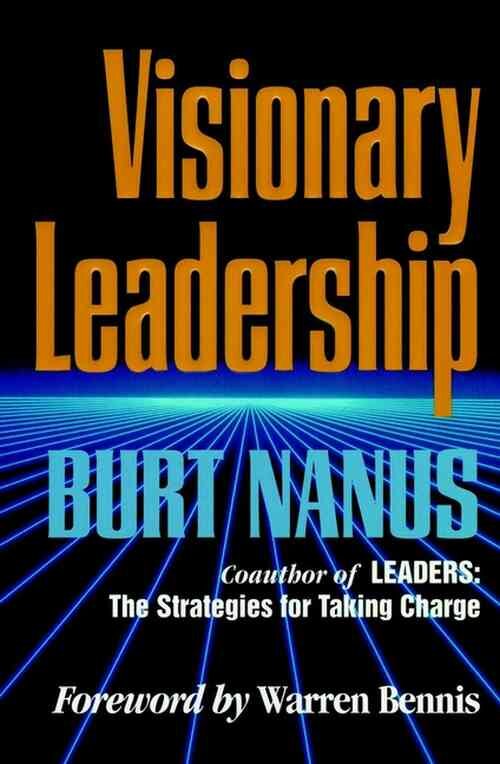Burt Nanus, Visionary Leadership: Creating a Compelling Sense of Direction for Your Organization. Jossey-Bass, 1995.
LifeandLeadership.com Summary
This is a good expression of transformational and empowering leadership philosophies, emphasizing the importance of developing and unleashing people through an inspiring vision of what can be accomplished. This remains one of the best business-based resources on the subject.
Most authors who write on vision are not visionaries, they are goal setters. Vision is a unique entity, and usually only visionaries are able to detect the difference between true vision and statements of mission, goals, objectives, values, etc. Nanus is one of the clearest guides to understanding authentic vision.
In Part One, What Vision Is and Why It Matters, he states the main message of the book: There is no more powerful engine driving an organization toward excellence and long-range success than an attractive, worthwhile, and achievable vision of the future, widely shared. (3) Most of the best definitions of vision are simply revisions of Nanus:
A realistic, credible, attractive future for your organization. It is your articulation of a destination toward which your organization should aim, a future that in important ways is better, more successful, or more desirable for your organization than is the present. …A vision is only an idea or an image of a more desirable future for your organization, but the right vision is an idea so energizing that it in effect jump-starts the future by calling forth the skills, talents, and resources to make it happen. (8)
Nanus defines the role of leaders in effecting vision, arguing that it is indeed a function of leading the future, not managing the present. These two forces must be balanced, however, and it is the leader’s task to balance them by executing four roles: direction setter, change agent, spokesperson, and coach. He instructs the leader on criteria for recognizing when a vision is truly good for the organization.
Part Two, Developing the Vision, discusses how to assess the current operational climate through a vision audit, test the reality of a vision against constituent needs and organizational boundaries, conceive the broad range of potential futures, gestate and synthesize these findings into a reasonable set of alternative visions, check these alternatives against good criteria, and the crystallize the final statement.
Part Three, Implementing the Vision, covers translating the vision into reality by communication, networking, and leadership personification. This section also contains good insight on the leader’s role as change agent, overcoming resistance to change, and reshaping the organizational climate through values, performance measures, organizational strategies, and operational policies. Also, in the tradition of the “learning organization,” Nanus discusses periodic revisioning as the context changes.
As far as applicability to churches, remember that Nanus, as most business writers, assumes the leader possesses certain controls and incentives with employees that most ministers do not possess in the same measure. Even with this caveat, no one should try to “do” vision without reading this volume.
From the Publisher
Warren Bennis writes, “the book fills me with equal amounts of admiration and envy.” For the first time ever, Nanus defines for us what ‘the vision thing’ is all about.
Successful leaders know that nothing drives an organization like an attractive, worthwhile, achievable vision for the future. Leadership expert and best-selling author Burt Nanus finally shows why vision is the key to leadership and demonstrates how any leader can use a logical, step-by-step process to create and implement a powerful new sense of direction in his or her organization.
Designed for individual leaders to develop their own vision statement, this book guides readers through the mechanics of forming a vision, guidelines for developing the scope of the vision, and processes for implementing that vision.
Visionary Leadership is an indispensable guide for leaders at all levels, from top executives to heads of divisions and departments, from large corporations to small businesses, from manufacturing and service organizations to government and nonprofit institutions.
About the Author
BURT NANUS is author or coauthor of six books including the best-selling Leaders: Strategies for Taking Charge (1985, with Warren Bennis). For many years, he was director of research at the University of Southern California’s Leadership Institute and professor of management in the School of Business Administration.
***For additional information on this resource, including reviews, click the bookstore links. Check the reference at page top or the links below for resource guides on related topics.***
Related Areas
See Other Resources on Church Leadership and Renewal:
- Church Leadership and Renewal, Index
- Church Leadership, Theological Foundations, Ecclesiology
- Church Leadership, Philosophical Foundations – e.g. Church Growth, Missional, Emergent, and Other Missionally Responsive Trajectories
- Church Leadership, Practical Foundations – Church Dynamics and Research
- Church Leadership, Practical Foundations – Congregational Culture, Church Identity
- Church Leadership, Practical Foundations – Size Dynamics, Size Transitions
- Church Leadership, Practical Foundations – Research and Case Studies on Effective Churches
- Church Leadership, Special Situations – Small Church Development
- Church Leadership, Strategies for Renewal
See Resources on Over 100 Areas of Ministry Leadership:


